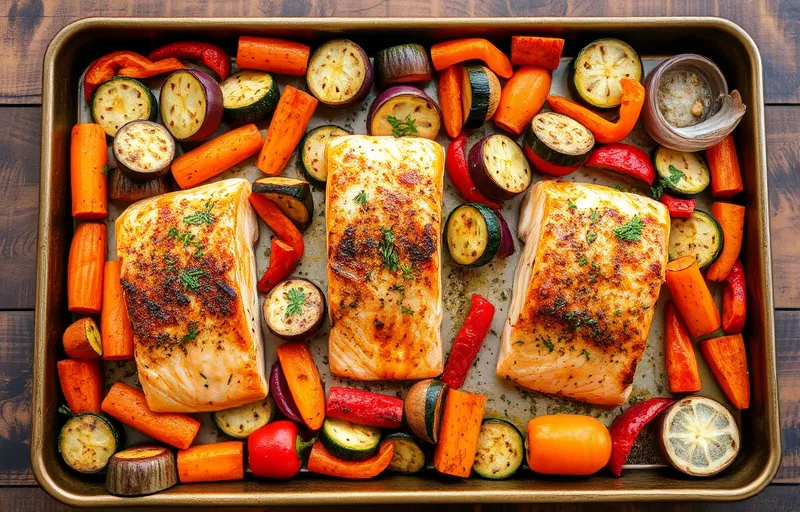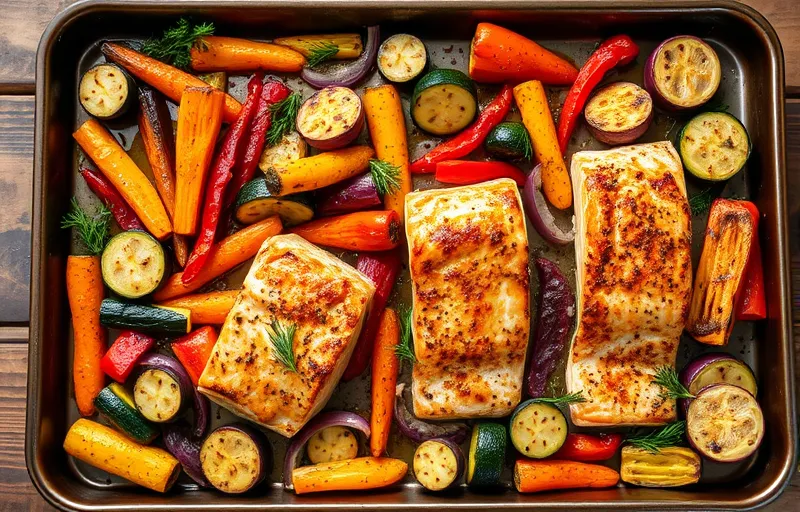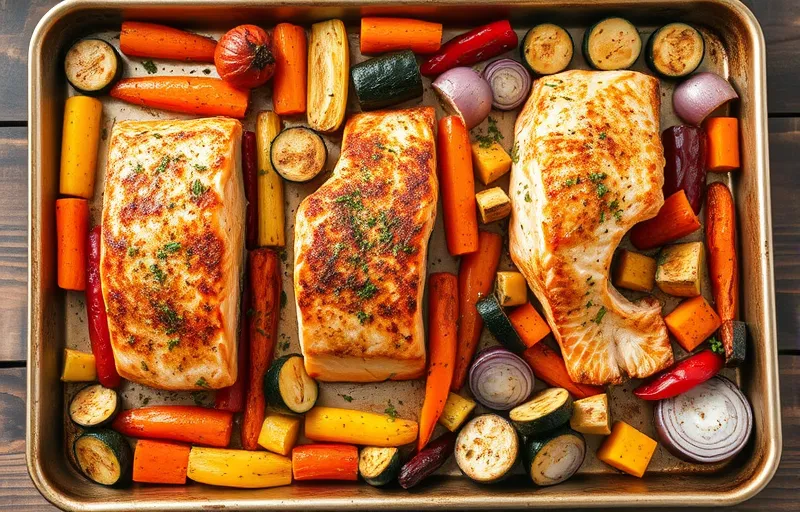Table of Contents
Introduction
When you’re looking for a healthy, delicious dinner that doesn’t take up much of your time or energy, Sheet Pan Salmon and Veggies is the perfect solution. This one-pan meal is not only quick and easy to prepare but also packed with essential nutrients, making it a balanced and wholesome option for any weeknight.
The beauty of a sheet pan meal lies in its simplicity. You can easily toss fresh ingredients—like salmon, colorful vegetables, and a light seasoning—onto a single baking sheet, pop it in the oven, and let the heat do all the work. In just about 30 minutes, you’ll have a flavorful, satisfying meal that requires minimal effort.
One of the standout benefits of this recipe is the minimal cleanup. Unlike traditional meals that require multiple pots and pans, this one-pan wonder only requires washing a single baking sheet and perhaps a cutting board. It’s ideal for busy cooks who want to spend less time cleaning up after dinner.
Not only is it convenient, but this sheet pan meal is a balanced meal in itself. Salmon is an excellent source of protein and omega-3 fatty acids, while the vegetables—like broccoli, carrots, and bell peppers—provide essential vitamins, fiber, and antioxidants. Together, they create a wholesome, satisfying dinner that won’t weigh you down but will leave you feeling nourished.
Whether you’re a beginner in the kitchen or a seasoned home cook looking for something quick and flavorful, Sheet Pan Salmon and Veggies is the perfect solution for busy weeknights when time is limited, and you still want to enjoy a nutritious, home-cooked meal.

Why Choose a Sheet Pan Meal for Dinner?
Sheet pan meals have become increasingly popular for good reason. They provide a variety of benefits that make them an ideal choice for dinner, especially for those with busy schedules. Here are three main reasons why you should consider choosing a sheet pan meal for your next dinner:
Easy Cleanup: The Convenience of One-Pan Meals for Busy Evenings
One of the biggest advantages of Sheet Pan Salmon and Veggies is the minimal cleanup they require. Traditional meals often involve several pots, pans, and utensils—each of which requires its own washing. With a Sheet Pan Salmon and Veggies meal, everything cooks on a single pan, which means there’s just one dish to clean afterward. Not only does this save time, but it also reduces the frustration of dealing with a pile of dirty dishes at the end of the day. After a long, hectic evening, the last thing you want to do is spend hours cleaning up, and a Sheet Pan Salmon and Veggies meal makes this process as quick and easy as possible.
Balanced Meal: Combining Protein (Salmon) and Vegetables (Broccoli, Carrots, Bell Peppers, etc.) for a Nutritious Dinner
Sheet Pan Salmon and Veggies meals are also an excellent way to create a balanced meal in one go. By combining high-protein foods like salmon with a variety of vegetables, you get all the essential nutrients your body needs in one dish. Sheet Pan Salmon and Veggies is rich in healthy omega-3 fatty acids, which are known to improve heart health and reduce inflammation. The vegetables—such as broccoli, carrots, bell peppers, and zucchini—are loaded with vitamins, minerals, and fiber that support digestion, boost immunity, and contribute to overall well-being. By cooking everything on the same pan, you not only save time but also ensure that your Sheet Pan Salmon and Veggies dinner is well-rounded and nutritious.
Time-Saving: How Sheet Pan Meals Save Time in Both Prep and Cooking
When it comes to busy weeknights, time is precious. One of the biggest advantages of Sheet Pan Salmon and Veggies meals is their efficiency in both prep and cooking. Unlike more intricate recipes that require several steps and hours of attention, Sheet Pan Salmon and Veggies meals are quick to prepare. Simply chop your vegetables, season your protein, and arrange everything on the sheet pan. From there, the oven does the work, leaving you with more time to relax or take care of other tasks. Additionally, because everything cooks at once, you won’t have to worry about juggling multiple cooking times or pots on the stove. Most Sheet Pan Salmon and Veggies meals, including salmon and veggies, cook in 25–30 minutes, making them a fantastic option for those tight on time but still wanting a home-cooked, nutritious dinner.
This expanded section highlights the key benefits of Sheet Pan Salmon and Veggies—easy cleanup, balanced nutrition, and time-saving convenience—all of which make them a perfect solution for busy dinners. These points also help to emphasize the value of this cooking method, making it an even more appealing choice for readers.
The Best Vegetables to Pair with Salmon on a Sheet Pan
When making a Sheet Pan Salmon and Veggies dish, selecting the right vegetables is key to creating a balanced, flavorful, and well-cooked meal. The vegetables you pair with your Sheet Pan Salmon and Veggies should not only complement the taste of the fish but also cook at a similar rate to ensure everything is ready at the same time. Here are some of the best vegetables to include in your Sheet Pan Salmon and Veggies meal:
Broccoli: High in Nutrients, Cooks Perfectly with Salmon
Broccoli is an excellent choice for any Sheet Pan Salmon and Veggies meal. It’s packed with nutrients, including vitamin C, fiber, and antioxidants, which support your immune system and overall health. Broccoli’s natural flavor, slightly earthy and mildly bitter, pairs wonderfully with the rich, savory taste of salmon. When roasted on a Sheet Pan Salmon and Veggies, broccoli becomes tender yet retains a slight crispness, making it a perfect match for salmon. The cooking time for broccoli is ideal—it takes just the right amount of time to soften and caramelize while the salmon is cooking, so you don’t have to worry about overcooking either ingredient.
To bring out the best in broccoli, consider seasoning it with olive oil, garlic, and a squeeze of lemon. These flavors elevate the broccoli and add depth to the Sheet Pan Salmon and Veggies dish, balancing the richness of the salmon.
Carrots & Bell Peppers: Add Sweetness and Color to the Dish
Carrots and bell peppers not only bring vibrant color to your Sheet Pan Salmon and Veggies but also provide a sweet contrast to the savory salmon. Carrots are packed with beta-carotene (which the body converts into vitamin A), and they also offer a mild sweetness and crisp texture when roasted. Their natural sweetness intensifies in the oven, complementing the umami of the salmon beautifully in the Sheet Pan Salmon and Veggies meal.
Bell peppers—whether red, yellow, or orange—add a pop of color and a mild sweetness to the Sheet Pan Salmon and Veggies dish. They also have a slight tang and crunch when roasted, making them a wonderful contrast to the tender salmon. Bell peppers are high in vitamin C, antioxidants, and fiber, making them a nutritious addition to your Sheet Pan Salmon and Veggies meal.
Together, carrots and bell peppers create a flavorful and colorful medley that enhances the visual appeal of your Sheet Pan Salmon and Veggies and adds a variety of textures and tastes.
Asparagus & Zucchini: Light, Healthy, and Cooks in the Same Time Frame as Salmon
For a light, healthy addition, consider adding asparagus and zucchini to your sheet pan salmon meal. These vegetables are not only nutritious but also cook at the same time as the salmon, making them ideal for one-pan cooking.
Asparagus is a great source of fiber, folate, and vitamins A, C, and K. When roasted, asparagus becomes tender with crispy tips, creating a perfect contrast to the tender salmon. Its earthy, slightly grassy flavor pairs wonderfully with the richness of the fish, and it’s one of the fastest-cooking vegetables, ensuring it doesn’t overcook during the salmon’s roasting time.
Zucchini is another fantastic choice. Light and versatile, zucchini adds a soft, mild flavor to your dish without overpowering the salmon. Zucchini is also a great low-calorie vegetable that’s high in water content and loaded with antioxidants. When roasted, it softens and caramelizes, blending seamlessly with the salmon while maintaining its delicate flavor.
Both asparagus and zucchini require minimal preparation—just a quick trim for the asparagus and slicing for the zucchini—and they cook at the same temperature as the salmon, ensuring that everything is ready at the same time with minimal effort.
How to Prepare the Salmon for Perfect Results
The key to a perfect sheet pan salmon and veggies dish lies in preparing the salmon correctly. From selecting the right fillets to seasoning and cooking them to perfection, every step counts to ensure your salmon turns out tender, juicy, and flavorful. Here’s how to prepare the salmon for the best results:

Choosing the Right Salmon: Tips for Selecting Fresh or Frozen Salmon Fillets
The first step in preparing a delicious salmon dish is choosing high-quality salmon. Whether you opt for fresh or frozen, the quality of the fish will have a significant impact on the final result. Here are some tips for selecting the best salmon:
- Fresh vs. Frozen Salmon: Both fresh and frozen salmon can be excellent choices, as long as they’re handled and stored properly. Fresh salmon should have a bright, vibrant color and a clean, ocean-like scent. It should not smell overly fishy or sour. If buying frozen, look for fillets that are flash-frozen to preserve freshness. Make sure the fish is free from any ice crystals or freezer burn, as these can affect the texture and flavor.
- Wild-Caught vs. Farmed Salmon: Wild-caught salmon is often considered the best option due to its rich flavor and firmer texture. It also tends to have a higher omega-3 content. However, farmed salmon is more readily available and can be a good choice if you’re on a budget. Look for certifications like MSC (Marine Stewardship Council) for sustainably sourced wild-caught salmon.
- Fillet or Whole Salmon: While you can use a whole salmon for filleting at home, salmon fillets are the easiest and most convenient option for a sheet pan meal. They cook quickly and evenly, making them perfect for one-pan meals.
Seasoning Your Salmon: Simple Seasoning with Olive Oil, Garlic, Salt, and Pepper
Once you’ve selected your salmon, it’s time to season it. Salmon has a rich, flavorful taste that can be enhanced with a few simple ingredients. Here’s a basic yet delicious seasoning combination:
- Olive Oil: Drizzle the salmon fillets with olive oil, which not only helps the fish cook evenly but also adds a rich flavor and promotes a golden, crispy exterior. Olive oil also helps the seasoning to adhere to the fish.
- Garlic: Freshly minced garlic or garlic powder adds an aromatic, savory kick to the salmon. Garlic works beautifully with salmon, infusing it with a mild, roasted flavor when baked in the oven.
- Salt and Pepper: A simple seasoning of salt and pepper can go a long way in bringing out the natural flavors of the salmon. Be sure to season generously to ensure that each bite is well-seasoned.
- Additional Seasonings (Optional): For added flavor, you can experiment with other spices and herbs, such as paprika, lemon zest, dill, or thyme. A squeeze of fresh lemon juice after cooking adds a refreshing brightness to the dish.
Simply rub the seasoning mixture onto the salmon fillets, ensuring that both sides are coated evenly. Let it sit for a few minutes to absorb the flavors before placing it on the sheet pan with the vegetables.
Cooking Time for Perfect Salmon: How Long to Cook Salmon for a Tender, Flaky Texture
The cooking time for salmon can vary depending on the thickness of the fillet, but for sheet pan meals, the goal is to achieve perfectly cooked salmon that is tender and flaky. Here’s how to get it just right:
- Temperature: Preheat your oven to 400°F (200°C). This temperature is ideal for both the salmon and the vegetables, allowing them to roast evenly without overcooking.
- Cooking Time: As a general rule, salmon fillets need about 12-15 minutes in the oven, depending on their thickness. A good guideline is to bake salmon for 10 minutes per inch of thickness. Check the fillet by gently pressing it with a fork—if it flakes easily, it’s done. Overcooking salmon can result in a dry texture, so keep an eye on it.
- Juiciness and Flakiness: Salmon is best when it’s moist and flaky, so avoid overcooking. You can also use a meat thermometer to ensure the internal temperature reaches 145°F (63°C), which is the recommended safe temperature for cooked salmon.
By following these simple steps, you’ll achieve a perfectly cooked salmon that’s tender, juicy, and full of flavor, complementing the vegetables in your sheet pan meal.
Step-by-Step Guide to Making Sheet Pan Salmon and Veggies
Creating the perfect Sheet Pan Salmon and Veggies dish is simple, but a little attention to detail can make all the difference in achieving a meal that’s both flavorful and well-cooked. Follow these easy steps for a delicious, balanced dinner that comes together with minimal effort:
Prepping the Ingredients: Wash and Chop Vegetables, Season Salmon
The first step in preparing a Sheet Pan Salmon and Veggies meal is prepping the ingredients. Having everything ready before you begin assembling the dish will make the process smoother and faster.
- Wash the Vegetables: Start by thoroughly washing your vegetables to remove any dirt or pesticides. If you’re using vegetables like broccoli, carrots, bell peppers, zucchini, or asparagus, rinse them well under cold water and pat them dry with a towel. Dry vegetables cook more evenly, helping to achieve the perfect texture.
- Chop the Vegetables: After washing, chop the vegetables into uniform pieces. Carrots can be sliced into rounds or sticks, bell peppers into strips, zucchini into half-moons, and broccoli into florets. The size of the vegetable pieces is important to ensure everything cooks evenly. If your vegetables are cut too large, they may take longer to cook, while smaller pieces may become overcooked.
- Season the Vegetables: Place the chopped vegetables in a large bowl and toss them with olive oil, salt, pepper, and any additional seasonings you prefer. You can add a sprinkle of garlic powder, paprika, or fresh herbs like thyme or rosemary to enhance the flavor. Toss the vegetables until they are evenly coated.
- Season the Salmon: While your veggies are prepped, take the salmon fillets and season them. Drizzle the fillets with olive oil, then rub them with minced garlic, salt, and pepper. You can also add a sprinkle of paprika or lemon zest for extra flavor. Let the salmon sit for a few minutes to allow the seasoning to absorb.
Arranging on the Sheet Pan: How to Arrange Veggies and Salmon for Even Cooking
The way you arrange the vegetables and salmon on the sheet pan can significantly impact the evenness of cooking and the overall quality of your Sheet Pan Salmon and Veggies dish.
- Prepare the Sheet Pan: Line a large baking sheet with parchment paper or lightly grease it with olive oil to prevent the ingredients from sticking. This will also make cleanup much easier.
- Arrange the Vegetables: Start by arranging the seasoned vegetables on the sheet pan. Place the harder vegetables (like carrots and broccoli) first, as they take a little longer to cook than the softer vegetables (like zucchini and bell peppers). Make sure the vegetables are spread out in a single layer, as this will allow them to roast evenly and caramelize nicely.
- Leave Space for the Salmon: After laying out the vegetables, make space for the salmon fillets. Ideally, you should have a small gap between the vegetables and the salmon to allow air to circulate and ensure even cooking. Placing the salmon fillets in the middle or along the sides works well, depending on the size of your pan.
- Add the Salmon: Gently place the seasoned salmon fillets on the sheet pan. If you want extra crispy skin, place the salmon skin-side up. The skin will crisp up beautifully in the oven, adding texture to the dish. Make sure the fillets are not overcrowded, so they have enough space to cook evenly.

Roasting to Perfection: Roasting Temperature and Time for the Perfect Texture
Now that everything is arranged on the sheet pan, it’s time to roast everything to perfection. The key to a successful Sheet Pan Salmon and Veggies meal is monitoring the temperature and cooking time carefully.
- Preheat the Oven: Set your oven to 400°F (200°C) and allow it to preheat. This temperature is ideal for roasting both the salmon and vegetables, ensuring a nice caramelization on the veggies while cooking the salmon to a tender, flaky texture.
- Roasting Time: Depending on the thickness of the salmon fillets and the types of vegetables you’ve used, the roasting time can vary slightly. However, a general guideline is to roast for about 20-25 minutes. After about 10 minutes, check the vegetables and toss them gently with a spatula to ensure even roasting. The salmon should be perfectly tender and flaky by the end of the cooking time, with a golden-brown crust on the vegetables.
- Checking for Doneness: The salmon is ready when it flakes easily with a fork and has reached an internal temperature of 145°F (63°C). If you’re unsure, you can use a thermometer to check the salmon’s internal temperature for perfect doneness.
- Optional: Broil for Crispiness: If you want a slightly crispy finish on your salmon, you can set your oven to broil for the last 2-3 minutes of cooking. Watch carefully to avoid burning, but this can help achieve a golden, crispy crust on the fish.
Once everything is cooked to your liking, remove the sheet pan from the oven. Let the salmon rest for a couple of minutes before serving to allow the juices to redistribute. Enjoy your delicious Sheet Pan Salmon and Veggies!

